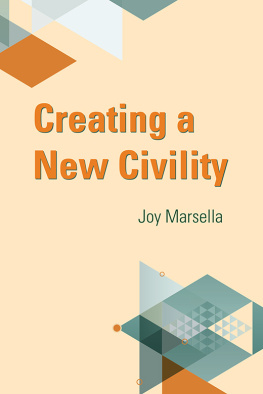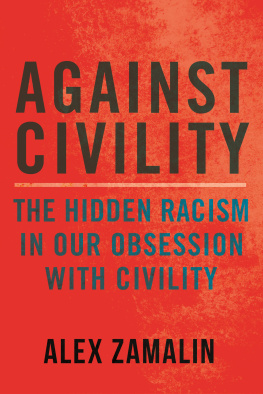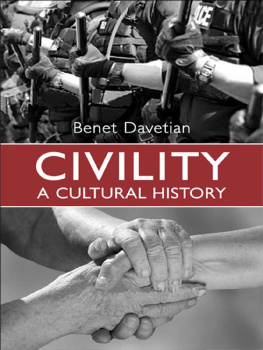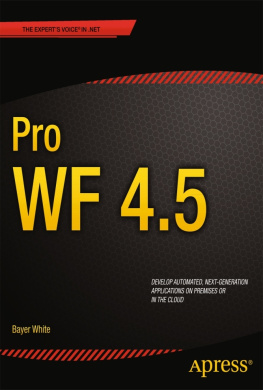Lewena Bayer - Civility at Work
Here you can read online Lewena Bayer - Civility at Work full text of the book (entire story) in english for free. Download pdf and epub, get meaning, cover and reviews about this ebook. year: 2021, publisher: Business Expert Press, genre: Politics. Description of the work, (preface) as well as reviews are available. Best literature library LitArk.com created for fans of good reading and offers a wide selection of genres:
Romance novel
Science fiction
Adventure
Detective
Science
History
Home and family
Prose
Art
Politics
Computer
Non-fiction
Religion
Business
Children
Humor
Choose a favorite category and find really read worthwhile books. Enjoy immersion in the world of imagination, feel the emotions of the characters or learn something new for yourself, make an fascinating discovery.
- Book:Civility at Work
- Author:
- Publisher:Business Expert Press
- Genre:
- Year:2021
- Rating:5 / 5
- Favourites:Add to favourites
- Your mark:
- 100
- 1
- 2
- 3
- 4
- 5
Civility at Work: summary, description and annotation
We offer to read an annotation, description, summary or preface (depends on what the author of the book "Civility at Work" wrote himself). If you haven't found the necessary information about the book — write in the comments, we will try to find it.
Civility at Work — read online for free the complete book (whole text) full work
Below is the text of the book, divided by pages. System saving the place of the last page read, allows you to conveniently read the book "Civility at Work" online for free, without having to search again every time where you left off. Put a bookmark, and you can go to the page where you finished reading at any time.
Font size:
Interval:
Bookmark:

Civility at Work
Civility at Work
How People Treatment is a Critical Success Driver for Business
Lewena Bayer
With contributions by Christian Masotti

Civility at Work: How People Treatment is a Critical Success Driver for Business
Copyright Lewena Bayer, 2021.
Cover design by Charlene Kronstedt
Interior design by Exeter Premedia Services Private Ltd., Chennai, India
All rights reserved. No part of this publication may be reproduced, stored in a retrieval system, or transmitted in any form or by any meanselectronic, mechanical, photocopy, recording, or any other except for brief quotations, not to exceed 400 words, without the prior permission of the publisher.
First published in 2021 by
Business Expert Press, LLC
222 East 46th Street, New York, NY 10017
www.businessexpertpress.com
ISBN-13: 978-1-95334-980-4 (paperback)
ISBN-13: 978-1-95334-981-1 (e-book)
Business Expert Press Human Resource Management and Organizational Behavior Collection
Collection ISSN: 1946-5637 (print)
Collection ISSN: 1946-5645 (electronic)
First edition: 2021
10 9 8 7 6 5 4 3 2 1
This one is for you Denby. You are where I find my courage,
you are my compass. I love you like crazy cake bunny, Mom.
Description
In case you were not aware, research focusing on both Canadian and U.S. companies shows that a whopping 98 percent of people polled have experienced uncivil behavior on the job. And, according to the fourth annual study on Civility in America: A Nationwide Survey, conducted by global public relations firm Weber Shandwick and public affairs firm Powell Tate in partnership with KRC Research, civility in America continues to erode. This years study found that 70 percent of the Americans believe incivility has reached crisis proportions. Alarmingly, 81 percent of the Americans think that incivility is leading to an increase in violence at work. Notably, 80 percent of the people are dissatisfied with their jobs.
Increasingly, people are choosing employers who understand that civility is good business. In Civility at Work, Lew Bayer describes the business case for civility and explains how organizations can increase employee retention, performance, and overall revenue by creating a workplace culture of human kindness and civility.
Keywords
civility; retention; social intelligence; workplace culture; respectful workplace; civility at work
Contents
Fact: People treatment is a critical success driver for business. How organizations treat their employees generally, and more specifically how the policies and procedures, incentives, and best practices that direct and dictate the overall experience of human beings at work can make or break organizational success.
In three-time international bestselling book, The 30 percent Solution; How Civility at Work Increases Retention, Engagement and Profitability (Motivational Press 2016), we introduced the concept of civility (brand new to many) to organizations and individuals all over the world. Forward-thinking companies are understanding that to thrive in the new world of work, it is critical to embed civility in their core values, policies, procedures, and best practices. In our field work, we have seen measurable success in many organizations across sectors and around the globe. Some examples of these success stories are shared in the assignments and notes from the field sections of this book.
One of the reasons the team at Civility Experts Inc. have had success in the field is because the Civility Experts Inc. approach to civility is to do a comprehensive assessment to identify which of the four core civility competencies are lacking in an organization and to identify which of the four cultural components that support a successful civility initiative are, or are not, present in the workplace. Then, the team customizes a strategic civility solution, and so you are aware, this solution does not always include civility training. In addition, a thorough postsolutions evaluation is completed to understand the measurable impacts of the workplace civility initiative to the employees, to the organization, to the bottom line, and also to the community.
This process is based on the path to civility formula, depicted in .
Others in the field are reporting positive progress as well. As one example, The Weber Shadwick 2019 Civility in America Poll found that while the majority of Americans still agree that incivility is a serious problem in society overall, over the past three years, 89 percent polled say their workplace is more civil. This is a significant change from 2015 where 87 percent of people polled said that their workplaces were uncivil.

Figure I.1
The latest installment of the study also shows that respondents feel social media are contributing heavily to the cause of incivility, with 63 percent of the Americans reporting that the impact of social media on civility has been more negative than positive. Previous studies did not highlight media or social media as primary causes.
On the surface, that 89 percent of the people polled say their workplaces are more civil now than they were in 2015 seems like good news. However, at a closer look, the numbers just do not add up. I wonder if the perceived increase in civility has more to do with the general increase in discussions and provision of tools and policies related to civility resulting in a perception of increased civility, or, has civil behavior actually increased. Based on what the research is saying about increases in stress levels and mental wellness, I would suggest that things are not so different than they were 5 to 7 years ago, or that they are different, but not necessarily better.
With 2019 Weber Shadwick research stating that the average person encounters incivility an average of 2.4 times a day and 10.2 times during a work week, I propose that dealing with incivility has simply become a way of life for many. I would suggest that we will want to keep a close eye on the trends and expectations for civility onlinethis as our day-to-day work applications for online training, conference calls, chat, and so on has increased significantly.
In addition, the past decade has been fraught with significant social change. For example, events such as #metoo, the new normal in world politics, for example, presidential tweets, economic fluctuations, global pandemics, increasing world hunger, and the list goes on, have significantly impacted the way we live, work, think, and interact. Specifically, many of us are barely surviving, and so, on the surface, social niceties seem a distant add-on.
One might think that with people interacting less due to being forced to work from home since the COVID-19 pandemic, things would be simpler. But, the reality is, working remotely carries with it all kinds of unexpected stressors, and sadly, with limited opportunities for real live interactions, remedy and repair can be problematic as well. As we move further into a work world where technology can simultaneously obligate or obscure transparency, where it is becoming increasingly difficult to differentiate between shades of truth and fabrication in everything from photos to profiles to documents and even integrity metrics, and where experiencing high touch, live human communication is quickly being replaced by replicas and automation, the remnants of positive people treatment are increasingly important.
Font size:
Interval:
Bookmark:
Similar books «Civility at Work»
Look at similar books to Civility at Work. We have selected literature similar in name and meaning in the hope of providing readers with more options to find new, interesting, not yet read works.
Discussion, reviews of the book Civility at Work and just readers' own opinions. Leave your comments, write what you think about the work, its meaning or the main characters. Specify what exactly you liked and what you didn't like, and why you think so.











